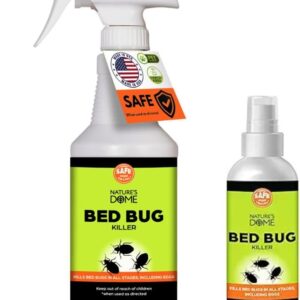Give No Pest a Chance in Your Home!
Great products for Pest Control!
Shop with usBest Sellers
-

M‑D 36″ Aluminum U‑Shape Screw‑On Under–Door Seal with Kick Plate
$32.90 Buy Now -

Anchor Hocking 26‑Piece SnugFit Glass Storage Set
$35.24 Buy Now -
Sale!

Solar Ultrasonic Animal Repellent 2-Pack, Motion Sensor Cat and Deer Deterrent
$49.99Original price was: $49.99.$39.99Current price is: $39.99. Buy Now -
Sale!

MaPorch 6″x120FT Solar Panel Bird Proofing Mesh Kit, With 60 clips
$89.99Original price was: $89.99.$80.99Current price is: $80.99. Buy Now -

TIMESETL 304 Stainless Steel 10-Mesh Wire Sheet, 12 x 24 inches
$13.99 Buy Now -

8-Pack Floor Vent Mesh Covers, 5.5 x 12 in Magnetic Register Screens
$16.99 Buy Now -
Sale!

Natural Lice, Mite and Bed Bug Spray + Laundry Additive Bundle, Child and Pet Friendly
$51.25Original price was: $51.25.$44.99Current price is: $44.99. Buy Now -
Sale!

36-Pack Natural Mole & Vole Repellent
$29.99Original price was: $29.99.$26.99Current price is: $26.99. Buy Now
Recent Additions
-

60-Pack Yellow Sticky Traps for Fungus Gnats and Fruit Flies
$14.99 Buy Now -
Sale!

4 Pack Solar Ultrasonic Nocturnal Animal Repeller with Red and Blue Predator Lights
$35.99Original price was: $35.99.$32.99Current price is: $32.99. Buy Now -
Sale!

Extra Strength Bed Bug Spray 128 oz + XL Unisex Coveralls Bundle
$81.98Original price was: $81.98.$73.78Current price is: $73.78. Buy Now -
Sale!

Bed Bug Spray Extra Strength 24 oz + Disposable Coveralls Medium Bundle
$39.74Original price was: $39.74.$35.76Current price is: $35.76. Buy Now -

Harris Queen Bed Bug Proof Mattress Encasement, Waterproof Protector
$31.99 Buy Now -
Sale!

Ortho Home Defense Max 3-Step Bed Bug Solution System
$52.97Original price was: $52.97.$45.53Current price is: $45.53. Buy Now -
Sale!

Nature’s Dome Bed Bug Spray: Lasting Defense, 16 oz + 3.4 oz
$32.44Original price was: $32.44.$29.99Current price is: $29.99. Buy Now -
Sale!

Steri-Fab All-in-One Disinfectant & Insecticide Spray, 16 oz,
$28.13Original price was: $28.13.$26.23Current price is: $26.23. Buy Now